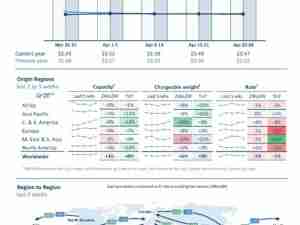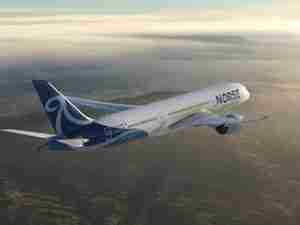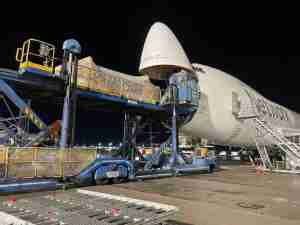Southwest Airlines Co. is looking to raise about $2.6 billion by selling shares and convertible notes, stepping up a push to add liquidity as the coronavirus pandemic all but erases demand for flights.
The carrier will offer 55 million shares, which would bring in about $1.6 billion at current prices, plus an over-allotment option for the underwriters. Southwest also is selling $1 billion in convertible notes due in 2025, according to a statement Tuesday after the company reported its first adjusted quarterly loss in eight years.
Southwest is following United Airlines Holdings Inc. in offering equity amid the biggest crisis in the industry’s history, as carriers rush to raise funds even after receiving billions of dollars in government aid. Southwest is also cutting the number of Boeing Co. 737 Max jets it will take through December 2021 by more than half, and said the travel outlook demand remains bleak.
“While United’s equity offering last week raised investor fears of similar action at other airlines, what has been surprising is the participation by airlines with very strong liquidity positions,” Savanthi Syth, an analyst at Raymond James, said in a note to clients on Southwest. “This implies no airline is immune to shareholder dilution.”
The shares were little changed at $29.13 at 10:24 a.m. in New York. Southwest dropped 46% this year through Monday, the best performance on a Standard & Poor’s index of major U.S. carriers.
Downturn ‘Doozy’
Southwest has raised $5.2 billion in debt since the start of the year and still has nearly $8 billion in unencumbered assets. Chief Executive Officer Gary Kelly said the company would try to raise more money even after the new offerings.
“This is a doozy,” he said in an interview on CNBC, referring to the travel collapse. “As a world, we just weren’t prepared for this pandemic. We need to be better prepared next time around and hopefully it won’t be for another century.”
The equity and debt offerings are expected to price Tuesday after the market closes, a person familiar with the matter said, following one session of investor marketing. The convertible bonds are offered at a 2% to 2.5% coupon and a 30% to 35% conversion premium, the person added. The underwriters can also buy an extra $150 million in the bonds, which are due 2025.
The equity component doesn’t have a price range. The stock offering plus the over-allotment option of 8.25 million shares represent about 12% of Southwest’s current outstanding shares. Blomberg News reported late Monday that the deals were in the works.
“The company is in a strong liquidity position and is in good shape to weather the near-term demand decline,” Helane Becker, a Cowen & Co. analyst, said in a note to clients. The $2.6 billion proceeds from the equity and notes sales will “further bolster” that stance.
Morgan Stanley, Bank of America Corp., JPMorgan Chase & Co., BNP Paribas and Citigroup Inc. are the joint book-running managers of the offerings.
Max Deferrals
Southwest is also rushing to cut costs. Deliveries of the 737 Max from Boeing will total no more than 48 through the end of next year. The Dallas-based airline had been scheduled to receive 123 Max jets from Boeing and aircraft lessors through the end of 2021, Chief Financial Officer Tammy Romo said.
Under the reworked delivery schedule, the company this year will take fewer than the 27 jets it had been expecting. Also, the carrier will remove the Max from its schedule until late October of this year as Boeing works to end a grounding that began in March 2019 after two deadly crashes.
With far fewer customers on planes, operating revenue will fall as much as 95% in April and May and revenue trends are too hard to predict after that, Southwest said.
Despite slashing capacity over the two months, the proportion of seats filled per plane will average 6% in April and 5% to 10% in May, the airline said. The average last year was more than 83%.
Economic ‘Standstill’
“The U.S. economy has been at a standstill, and the current outlook for second quarter 2020 indicates no material improvement in air travel trends,” Kelly said. “Trip cancellations remain at unprecedented levels, though they have receded from their peak in March.”
Cost cuts and the dramatically reduced flight schedule should lower 2020 operating costs by $2 billion and capital spending will fall $1 billion, Southwest said. The results are already starting to show, with daily cash burn during the second quarter estimated at $30 million to $35 million—about half as much as the airline said it had initially expected.
The company has temporarily parked 350 aircraft, or roughly half its fleet. It has also frozen hiring, cut executive salaries and had 10,000 workers take a mix of voluntary unpaid leave and time off at reduced pay this month and next, Romo said in a message to employees. It’s considering voluntary retirement and long-term leave programs.
Kelly warned last week in an internal video that Southwest had to prepare for the risk of becoming “drastically smaller” if demand doesn’t pick up.
Government Aid
The airline intends to apply for a $2.8 billion secured loan from the U.S. Treasury Department but hasn’t decided whether it will ultimately take the funds. Southwest earlier got more than $3.2 billion—part grant and part loan—in payroll support from the Treasury.
Southwest reported an adjusted loss of 15 cents a share in the first quarter, a narrower shortfall than the 30-cent loss expected by analysts. This year’s result was the adjusted loss since early 2012, and the first on a net basis since 2011, according to data compiled by Bloomberg.
Sales fell 18% to $4.23 billion, trailing the $4.52 billion average of analyst estimates compiled by Bloomberg.
If stay-at-home restrictions start to be lifted, some improvement in travel demand may begin in June, Kelly said.
“A lot of people have made summer vacation travel plans and I think some people are anxious to begin to get back to their lives,” he said. “Seeing what demand is in July and August is real critical.”









